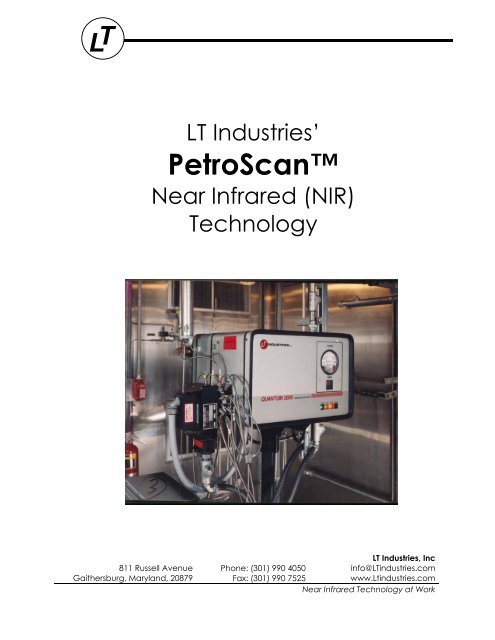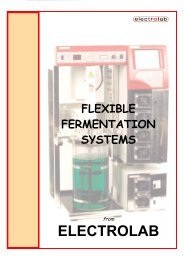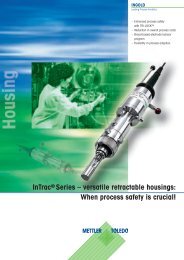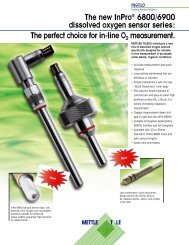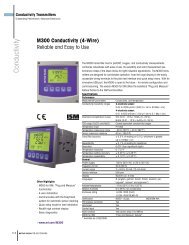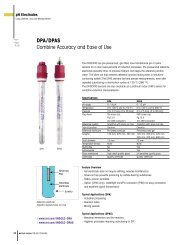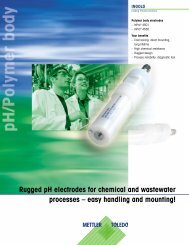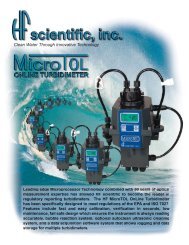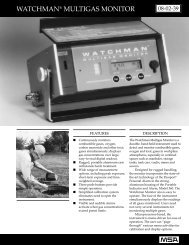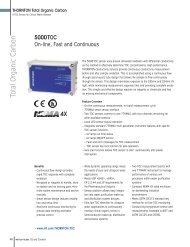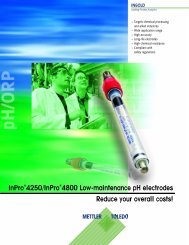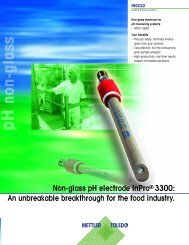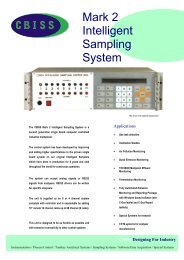PetroScan™
PetroScan™
PetroScan™
You also want an ePaper? Increase the reach of your titles
YUMPU automatically turns print PDFs into web optimized ePapers that Google loves.
L TLT Industries’PetroScanNear Infrared (NIR)Technology811 Russell AvenueGaithersburg, Maryland, 20879LT Industries, IncPhone: (301) 990 4050info@LTindustries.comFax: (301) 990 7525www.Ltindustries.comNear Infrared Technology at Work
Table of Contents1. Summary: Key advantages of LT’s PetroScan NIR technology ____________________ 32. LT Industries’ Company Information___________________________________________ 42.1 General ________________________________________________________________________2.2. Organization____________________________________________________________________2.3. References_____________________________________________________________________ 43. LT Industries’ NIR Technology _______________________________________________ 53.1. System Configuration ___________________________________________________________ 53.2. Project Structure _______________________________________________________________ 63.3. Typical Operations______________________________________________________________ 73.4. Laboratory analyzer ____________________________________________________________ 83.5. Absolute Reference Cell__________________________________________________________ 93.6. Optical Multiplexer ____________________________________________________________ 104. LT Industries’ Technological Advantages ______________________________________ 104.1. Hardware ____________________________________________________________________ 104.2. Spectra Acquisition ____________________________________________________________ 114.3. Calibration Methodology _______________________________________________________ 124.4. Model Maintenance ____________________________________________________________ 124.5. Analyzer Monitoring ___________________________________________________________ 124.6. Calibration Transfer ___________________________________________________________ 124.7. Near Infrared Training _________________________________________________________ 134.8. System Integration with DCS and PLC ____________________________________________ 13- 2 -
1. Summary: Key advantages of LT’s PetroScan NIR technology• Complete integration of predicted properties into your Distributed ControlSystem (DCS) for use in Blend Ration Control and Blend Property Controlpackages• Use of the blend’s recipe from the DCS to control which components will bemeasured in the blend• Prediction of Olefins, Aromatics, Benzene, Octane Numbers (Ron, Mon andRoad), Distillation Points, Oxygenates for Blender’s Output and componentstreams to meet the requirements of the reformulated gasoline complex modelmarket.• Laboratory Unit with identical optics to develop calibration and LT’s uniqueTRANS calibration transfer software to transfer the calibrations to the processanalyser. This is a key factor to speed the calibration development.• The Absolute Reference Cell (ARCell) is LT’s patented dual-flow sampling cellto provide robust self-referenced measurement.• Optical Multiplexer provides multiple measuring points per analyzer, reducingthe cost per individual measurement.• Internal In-line polystyrene wavelength calibration standard providescontinuos wavelength accuracy.• Sample Conditioning of the Blender’s Output and automatic outlier capture inall components streams.• Modem support for instant remote assistance anytime during the project.- 3 -
2. LT Industries’ Company InformationLT Industries designs, manufactures, sells and services state-of-the-art Near Infrared(NIR) electro-optic systems for measuring and characterizing chemical andphysical properties of materials used for process monitoring and controlapplications. Founded in 1981, LT Industries has developed and produced a seriesof Near InfraRed (NIR) systems over a 18-year period. The company has aninstalled base of about five hundred (500) systems, about 60% of which are used inprocess applications. The installed instrument base is geographically centered inNorth America and Europe, with recent expansion in Asia. The company hasstrong presence in the petroleum-refining market. The Texaco organization hasgranted LT Industries a worldwide approved-vendor status and has procures threeincreasingly larger blend monitor systems under that agreement.LT Industries has a patent estate that covers its unique technologies. The chiefareas of coverage are: NIR scanner drives which allow long field life of theequipment, sensing probe technology which permits precise measurement in spiteof artifacts such as bubbles and particles, and mathematical software whichenables transfer of statistical calibrations from instrument to instrument.LT Industries philosophy is to provide hardware and software to our customers andto provide exemplary support after sale. We work hard on each and everyinstallation making them showcases within their organizations as well as for ourown. Product continuity is maintained through upgrades. Software maintenancehas provided state-if-the-art performance without discarding whole systems. Infact, we have never obsoleted nor discontinued one of our products, but haveenabled our customers to take advantage of all our developments throughupgrade programs. Our commitment to non-obsolescence is unique in theindustry.New technologies are the key to survival in the long term. LT’s position in thisindustry has been to be the technology leader. We are continually improving andenhancing our multivariate calibration software and developing new instrumentsand accessories to complement our high-resolution line of NIR process systems.2.1. ReferencesLT has long experience both in the process applications and specifically in refineryand blending systems, ranging from one-stream one-property applications, to 16streams and 200+ properties. The specific list of references is included in theAppendix. Visit to installations that closely match your application can bearranged with previous notice.- 4 -
LT structures the NIR Process Analyzer based on key components that can becustomized to the installation’s specific requirements. Every blending installation issingular based on the refinery’s needs. It ranges based on the number of streamsto be measured, the properties to be measured in every stream, the use ofprotofuels (gold standard), the functionality and design of the sample conditioningsystem, how the predicted properties are transmitted to the distributed controlsystem, the control of field devices (solenoids, valves, temperature transmitters),etc.This range of options demonstrates the flexibility and scope of LT’s NIR technologyand the technological advance of its key products. The following section willdescribe the basic components of a process NIR Analyzer.3. LT Industries’ NIR Technology3.1. System ConfigurationThe components of a NIR Process Analyzer system are:I. Near Infrared Spectrometer Module: This module includes the NIRProcess Analyzer, as well as the computer, and all of the spectrometeroperations for spectral data acquisition, control, diagnostics and faultisolation.II.III.IV.Sample Conditioning Systems: This is a self-contained module that isbased on an Absolute Reference Cell and is responsible for samplecapture, temperature control, filtering and water removal. The controlof the Absolute Reference Cells is pneumatic and automaticallydirected by the Analyzer’s Controller.Analyzer System Control Computer: This module is the analyzer systemsupervisory computer. It handles all of the system operations rangingfrom spectral processing to communications with plant computersystems. System performance is continuously monitored and faultisolation and notification carried out. Full states, data and operationslogging are continuously available. The computer console is theprincipal means of maintenance and diagnostic operations.Calibration Development Support Services: Calibration, that is thedevelopment of the chemometrics estimators for the analysesprovided, involves analyses of analytical data from process samples.Expert application support from LT involved in this phase, based on LT’sextensive field experience.- 5 -
V. Universal Calibration: Provided by LT Industries. This large calibrationdatabase is used to refine the final calibration through the addition ofspecific “local” samples from the customer’s process.VI.VII.Modbus Interface: A software communication interface between theNIR analyzer and the Distributed Control System via an RS-232/RS-422signal using the Modbus protocol. The customer is responsible toconfigure the Distributed Control System to read-in the appropriateModbus values. Honeywell TDC3000, Foxboro I/A and other DCS arefully supported.Fiber Optics: The on-line analyzer requires fiber optic cables toconnect the Absolute Reference Cells (ARCell) to the spectrometer.These cables are 60 fiber "bundles" rather than single fibers becausebundles offer better reliability and provide more energy than singlefibers. Fiber optics allow safe remote measurement and combinedwith the optical multiplexer it is a key advantage for multi-pointanalysis.VIII. Field Sampling Units: Based on an Absolute Reference Cell (ARCell),can include an air actuator or solenoid for grabbing a sample fromthe component and Explosion Proof Temperature indication andtransmission.IX.Optical Multiplexer: 20 Channel optical multiplexer, including areference channel.These elements are complete except for local site preparation, local installationexpenses and non-NIR sampling and sample analysis costs, which are typicallyresponsibility of the customer. Manpower for training and support are estimatedbased on the scope of the project.3.2. Project StructureA typical blender application consists of the following phases:1. Project definition2. Detail design3. Operational definition4. Laboratory analyzer installation and training5. Calibration development based on universal calibration in the lab6. Process analyzer installation and training7. Integration with DCS and Refinery Information Systems8. Calibration transfer to the process- 6 -
9. Model evaluation and monitoring10. Personnel training: chemometric, operational and maintenance11. SupportLT’s methodology has been successfully proven in the field and is based onadapting key proprietary technologies to the installation’s needs. Near Infrared isthe measurement technique, and LT’s successful project methodology integratesalso systems engineering, process background, DCS integration and modellingexpertise for a complete turnkey installation.The Universal Calibration is used to provide a startup calibration. By combining theuniversal calibration with LT’s Calibration transfer software (TRANS), a model isproduced. Model evaluation provides feedback of the model’s performance andthe model is expanded with local samples to increase accuracy.3.3. Typical OperationsComponent quality determination is based on measuring the spectra of the NIRstream and applying the chemometric models developed for that stream. Thereare two separated elementsOperationally the prediction of component qualities is fully integrated with theblender’s DCS operation and is fully automated. A simplified sequence of theoperation is as follows:• A blend is started. The DCS, based on the components used in therecipe, commands the NIR analyzer to measure a sequence ofstreams• The NIR spectra of one stream is measured• The chemometric model is applied to the spectra and all properties ofthat component are simultaneously predicted• The predicted properties are transmitted through a Modbus link to theDCS• Next stream is selectedThis loop will continuously sample, measure, and transmit the properties of thestreams being used in the current blend. The command of the analyzer is beingcontrolled by the Distributed Control System. This enables a complete integrationof the analyzer into the blender operation, including commanding the anaylzer tostop measuring in between blends, measuring only those streams (components)being used in the current recipe, integrating the predicted values in the RefineryInformation System (plant-wide repository database and trending/monitoringsoftware).- 7 -
During normal operations, the Analyzer Control Computer will be unattended. Itwill be used as part of all of the normal maintenance items listed in the last section.In addition, status information will be available on the computer during certainerror conditions and other conditions that will result in an alarm type logic signalcondition to be posted into the process control computer. Special diagnosticroutines will be available for fault isolation and diagnosis in the event of analyzersystem failure or octane quality assurance failures.A outlier is defined as a sample whose properties are not represented in thecalibratrion set used to develop the NIR chemometric model. This can be causedby:• Operational conditions upset the sample presentation to the NIRanalyzer. This type of condition clears itself after a short period of time.Using the Absolute Reference Cell and appropriate sampleconditioning, this is minimized.• The component’s sample is compositionally outside the calibration setand need to be captured in order to expand the calibration domain.This may be caused by a component that have not been included inthe calibration model based on seasonal changes or changes in theblend recipe.The outlier detection occurs automatically as part of each measurement. Beforea model is applied to a component’s sample, the spectrum of the sample isevaluated to determine if the sample can be predicted or should it be classifiedas an outlier. Automatic outlier collection integrated in the sample conditioningsystems automatically will save a sample for lab analysis. Then a comparisonbetween the lab primary analysis and the spectra measured can evaluate theoutlier. The calibration may be expanded with this additional sample.3.4. Laboratory analyzerThe use of a NIR laboratory analyzer together with a process analyzer provides thefollowing key advantages to the project:• Calibrations can be developed in the lab analyzer while the processanalyzer is installed in the process. In general, setting up a lab analyzeris a lot faster than integrating the process analyzer in an analyzerhouse or waiting for appropriate fast loops to be installed, etc.• Personnel can be trained in the use and operation of the analyzerLT Industries’ unique Calibration Transfer software uses Pair-Matching algorithm thatminimizes the number of samples required to transfer a calibration from the lab tothe process. And given that both analyzers, the lab and the process, share thesame optic systems and the same optical sampling system (Absolute Reference- 8 -
Cells), the effectiveness of the calibration transfer is assured. This is a very importantaspect that impacts the schedule of the project, enabling very fast installations.The lab analyzer typical configuration is• Q1200 NIR Lab Analyzer• Analyzer controller (computer)• Lab ARCell• Fiber Optic• LT’s software suite: Spectrametrix, LightCal, TransThe following options are available:• Temperature control of the samples• Optical multiplexer• Temperature read-out3.5. Absolute Reference CellThe Absolute Reference Cell (or A/R Cell) is the heart of the analytical system. Thispatented LT Industries' invention is best described as a shuttle-based, dualpathlength flowcell.When the A/R Cell is installed, a flow controller sends the flow through the cell fromone side. The force of the liquid causes a shuttle containing two pieces of quartzto slide to one side. In this way, the optical beam passes through one piece ofquartz. The thickness of that piece of quartz is carefully controlled so that thesample optical pathlength is a fixed, known value (for example 15 mm).After spectra are collected for about 25 seconds (this time limit is programmable),the direction of the liquid flow through the cell is reversed. Now the liquid causesthe shuttle to move to the opposite side of the cell and presents the other piece ofquartz to the optical beam. This second piece of quartz has a thickness that isdifferent from the first pierce (for example, 5 mm). Spectra are again collected forabout 25 seconds.After this period of time, the flow rate is reversed and the sequence begins again.The spectra from the first 25 seconds (which used a 15 mm pathlength) is ratioed tothe spectra from the second piece of quartz (which used a 5 mm pathlength). Thisgives a ratioed spectrum with a nominal pathlength of 10 mm - just about right forgasoline.The overwhelming advantage of this technique is that any material in the samplethat is not related to the concentration of the properties being measured is- 9 -
eliminated. Thus small particles, bubbles, turbidity, etc. are eliminated from theanalytical measurement.As a result of this technique, the NIR Gasoline Analyzer is less sensitive totemperature fluctuations and other disturbances that usually cause other analyzersto give erroneous results.3.6. Optical MultiplexerThe Optical Multiplexer or MUX is a device that sequentially directs the outputradiation from the spectrometer to one of a series of sampling locations. LTIndustries' MUX has 20 channels which allow the use of 19 sampling locations and 1reference channel.The purpose of the reference channel is to provide a constant reference energylevel against which the performance of the system can be measured. In this way,the system performance can be quickly verified whenever the operator desires.Furthermore, the system performance can be automatically verified at a ratechosen to provide maximum reliability in the system.The channels in the MUX are designated 1, 2, 3, etc. through 20. Each channelcan be accessed in a sequential manner or access can be programmed basedon the installation's needs.4. LT Industries’ Technological Advantages4.1. HardwareThe Petroscan 2000 NIR Process Analyser employs a rapid scanning and highresolution grating to provide the necessary wavelength dispersion of the infraredlight.1. The spectrometer design employs fiber optics to couple the sample tothe spectrometer. This design separates the hydrocarbon-containing cellfrom all electrical components and provides an intrinsically safe design.It also permits an inherently modular design that permits thereplacement of entire modules in the event of failure, non-routineservice or future expansion of system capabilities.2. An Indium-Gallium-Arsenide semi-conductor detector will beused. This allows the spectrometer to be operated in a spectral regionthat optimizes the sensitivity of the measurements. This also allows the- 10 -
use of sample size characteristics that reduce or eliminate the needfor maintenance intensive filter sampling.3. Low Maintenance: The Analyzer System spectrometer hasexceptional up-time in excess of 99.6% annualized, includingpreventive maintenance. This being due to its ruggedness, simpledesign and few moving parts.4. Internal optical referencing and dark referencing are performedin the hardware and firmware of the spectrometer. This enhances thelong-term reliability of the system by enabling self-compensation formany of the key variables in the measurement. Internal quality controltests will identify any possible component degradation before failureof the analyzer.5. The spectrometer will be packaged in a temperature stabilized,purged NEMA 4X enclosure. Under normal operation the package willnot have to be opened.LT’s 20 channel optical multiplexer provides measuring of up to 19 channels. Onechannel is used for internal analyzer reference. A description of the analyzer isprovided in the Appendix.LT’s complete software suite consists of Spectrametrix, LightCal, Trans andAutoDiscrim. All software is fully integrated and provides full customization flexibility.4.2. Spectra AcquisitionIn the laboratory, the use of the Lab Absolute Reference Cell (Lab-ARCell) providesa robust automated procedure for sample measurement and spectra acquisition.Using simple menus, the user in the lab requires only a one-key approach. Afterintroducing a sample into the laboratory Absolute Reference Cell, the analyzer’scomputer will command the analyzer to measure a spectra, preprocess it, store itin the appropriate file and attach a time-stamp or other identification associatedwith the sample.The use of a bar code reader is optional, to facilitate the integration with existingLIMS systems.In the process, spectra acquisition is controlled by the Analyzer’s controller. Basedon the distributed control system’s command, a specific stream is measured. Thatrequires that the optical multiplexer moves to that channel. The NIR is acquiredand stored in the Analyzer’s controller, in order to apply a chemometric model forprediction. This is a completely automated operation with no human intervention.- 11 -
4.3. Calibration MethodologyLT’s calibration software is very powerful, including PCR, PLS and MLR calibrationalgorithms. Software is used together with procedures for sample selection,repeatable sample measurement, validation techniques and internal crossvalidation.Separate validation sets are used and are composed of samples notincluded in the calibration set.By starting the installation with a Lab NIR Analyzer and then transferring thecalibrations to the process, the total time required for the calibration is greatlyreduced.4.4. Model MaintenanceTo successfully implement a NIR measurement, LT includes as part of the projectthe following aspects:- Project management- Model development- Validation technique- Model maintenance- Hardware & Software maintenanceModel maintenance can be accomplished with LT’s remote on-line support.Model maintenance is integrated with refinery’s information about streamcomposition, seasonality, recipe variations, etc.The combination of AutoDiscrim discrimination software together with the LightCalquantitative models allows detection of the boundaries of the calibration. The useof sub-calibrations reduces the complexity of model maintenance, especially in aninstallation with multiple component streams.4.5. Analyzer MonitoringAutomatic diagnostics provide continuos analyzer monitoring. Internal wavelengthreference assures wavelength stability and self-correction.Monitoring can be performed from the DCS’s operator console. Basic alarmsprovide status information of the analyzer4.6. Calibration TransferLT’s unique calibration transfer software (TRANS) uses the pair-matching algorithmto minimize the number of samples required to transfer calibrations betweenanalyzers (from the lab to process) or to transfer the Universal Calibration to aspecific installation. TRANS is able to incorporate both the linear and non-lineardifferences between the analyzers and compensate them mathematically.- 12 -
TRANS is used together with LT’s methodology for calibration transfer. LT’sapplications scientist select appropriate samples that maximize informationcontent and make effective use of the calibration databases used. TRANSsoftware together with applications scientist expertise works for the customer inmaintaining the cost and time involved in developing the calibration databases.TRANS have been field-proven successfully and is detailed the appendix.4.7. Near Infrared TrainingA complete NIR School is included in this proposal. The objectives of the NIR Schoolis to provide the personnel with concepts and skills to:- Assess an Application -- Is this feasible by NIR?- Design the Experiment: Variability, Accuracy, Precision- Optimize NIR Analyser for Sample Type- Validity of Data -- Statistical Assessment- Develop a Calibration- Validate a Calibration- Utilize a Calibration- Maintain a Calibration- Customize an ApplicationIn order to provide these concepts, the NIR School is structure to cover thefollowing sections:- Near Infrared History and Principles- Experimental Design- Strategy for Successful Application- Practical NIR Implementation- LTI Software Overview- Modelling / Calibration- Batch Files- Calibration Transfer - TRANS- Calibration MaintenanceThe NIR School is customized to the customer’s installation. Practical hands-onsessions of the NIR School provide the required expertise to operate and maintainthe NIR Analyzer.4.8. System Integration with DCS and PLC- 13 -
From a system’s point of view, LT Industries’ NIR Process Analyzer provides an arrayof possibilities for complete system integration into a refinery’s information andcontrol environment.LT's Modbus interface for the Quantum Analyzer provides real-time communicationwith a Distributed Control System (DCS) through the Modbus protocol. The Modbusinterface integrates the predicted values as obtained from the Analyzer to becommunicated to a constituents database on the DCS. Activity on the analyzercan be triggered from the DCS providing complete control of the instrument andintegration with a plant-wide control system. Status and performance monitoringinformation is also communicated to the DCS.The operator can obtain directly in the console the predicted values of thechemometric models, perform basic diagnostics and also command the analyzerto measure a specific channel. During blending, the DCS will automatically directthe analyzer to measure only the streams that are being used in the specificrecipe. The predicted values from the analyzer can be integrated in a blenderoptimizer, like BOSS or Ratio Blend Controller (RBC), to maximize the informationavailable.There are two basic possibilities for integration: 4-20 mA signals for small systems,and LT’s Modbus Interface.When a small number of streams/properties are needed, the use of standard 4-20mA outputs provides a fast, reliable, proven transfer to the DCS. Digital outputs(Normally Close/ Normally Open) are used to indicate alarms to the DCS’soperator. The use of 4-20 mA outputs is limited when the number of values to betransmitted increases.The second, most commonly used, option for integration with DCS is the use of theModbus protocol. The Modbus is a fast industry-wide de-facto standard for datacommunication and LT’s Modbus interface provides a data channel forcontrol/handshaking signals, diagnostic and prediction of stream’s properties. Theinterface between the Analyzer’s controller and the DCS can be performed by aPLC, configured with two Modbus ports. Very basic ladder logic is required totransfer the values between the Analyzer’s controller and the DCS.LT’s Modbus Interface is completely developed by LT and therefore completesupport is provided, during configuration, installation and during the systemoperation. Given that the Modbus can only transmit integer values, appropriatescaling is used and the values are scaled back at the DCS.LT’s Modbus Interface has been successfully integrated with Foxboro’s I/A seriesand Honeywell’s TDC 3000 trough the Advance Process Manager Serial Interface.- 14 -


